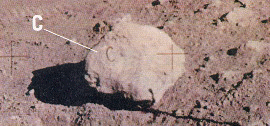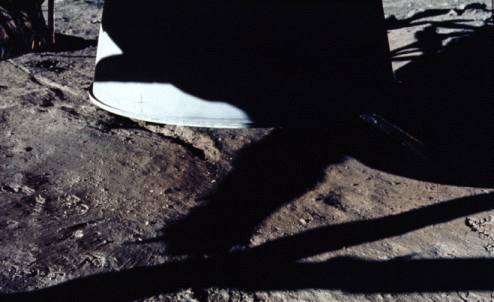|
|
|
Dust
The hoax geeks can't agree with each other on this one. No surprise when you consider just how barmy their theories are. Some put the above question, while others ask:
The lunar modules were equipped with extremely powerful rockets. Why is there no sign of the dust below the lander being disturbed by them?
So some want to know why there is no dust at the module's feet, and some want to know why there is undisturbed dust beneath the lander. Disturbingly, but not surprisingly, some manage to ask both questions practically in the same breath. Confused thinking or what?
Everyone was unsure before the lunar landings just how much dust there would be on the surface. Tests had been made, but sinking without trace was a serious proposition NASA had to consider. Fortunately in the event the amount of dust was less than that feared.
What the photos do show is that most of the dust below the landers had been blown away and the surface landed on was mostly solid rock. So little dust to settle into. You can see more about this further down the page when I discuss the lack of a crater beneath the LM.
 |
Why doesn't the dust stay in the air longer than in earth? Surely with the less gravity it would float around for ages? Why didn't any of the dust blasted up by the landing settle on the lander? |
Why can't people get to grips with how dust behaves in a vacuum? This is one of the most common reasons for confusion and claims of hoaxery that I come across. Let's get straight a few basic facts;
- Dust does not float in a vacuum. The only reason it 'floats' on Earth is because of the air. In a vacuum dust behaves exactly like any other object. You throw it up and it will then fall. It is no different from what a rock would do. Rocks do not float or billow around and the fact that dust is lighter makes no difference.
- Due to this lack of air dust falls quicker on the moon than on Earth. This may seem strange, as the Moon's gravity is much less. But the lack of an atmosphere is far more significant to the dust. But it still falls slower than you'd expect a rock to on Earth.
- These two facts make almost dead certain proof of a lunar landing. There is absolutely nowhere on Earth that you could make dust behave in this, to us, peculiar way. Create a vacuum on Earth and the dust would fall very quickly, just as we are used to a rock doing, but here is videoed evidence of dust behaving like it's in a vacuum and in low gravity. Without modern computer movie graphics there is no way this can be faked on Earth.
So why didn't any dust 'settle' on the lander? Well think for a moment; how the dust would be in a position to be above the lander to settle on it? The blast would throw the dust down and to the side. There is no air disturbance for the dust to billow around in. Throw the dust to the side and it will go that way, it won't come back. So how would you get any dust above the lander? And the dust wouldn't 'settle' any more than a rock 'settles', it falls.
Another example of the hoax geeks deciding on how something should behave on the moon when they know nothing of the facts. First of all the dust is not anything like sand. The particles are smaller and much more irregular. Sand on Earth is the result of weathering and has been rounded and smoothed by wind, water and oxidation, but dust on the moon are minuscule shards of broken rock from asteroid collisions. Consequently their surface at a molecular level is a jagged mass that won't get smoothed off and don't have any weathering to smooth them off. To cut a long story short, this means that when compressed, say by a boot, the dust particles will grip with each other very readily, using and retain the shape. All without any water.
OK, you're in the movie business and you're making up a set to look like the rocky surface of the moon. NASA wants this to look so precise that it'll fool the world. So you need plenty of rocks, like thousands of them, to scatter across your fake lunar landscape. Unlike most prop and set designers you are an absolute stickler for accuracy. That's why NASA gave you the job. Now any second rate designer would just scatter the rocks across the set. But not you. You are such a stickler that you have decided that every one of these thousands of rocks is going to be catalogued and labelled. It's a big task, but NASA want accuracy. So, how are you going to label the rocks? Hmm..... How about we start at rock 'A' and see how it goes? That'll give you at least ...oh.... 26... different rocks.
Doesn't ring true, does it? But in their relentless analysis of the photos the theoris have come up with a rock with a 'C' on it.

This is obviously a prop catalogue identification left visible by a careless set designer. How could anyone be so meticulous yet so careless?
Well, if it isn't a prop marking, what is it? I don't know. But I can think of plenty more plausible and unsinister explanations than a prop catalogue system that could only identify 26 different rocks. It could be a hair that got into the reproduction process. Most of the available lunar pictures are at least third generation and the pristine originals are safely locked away. Also on my list would be that someone has added the 'C' in. The theorist are keen in pointing out that NASA could tamper with the images, nothing is said about the fact that so could they.

There's no crater beneath the lander!
Lots of hoax geeks come up with this one as proof of a hoax. Few actually bother to look at the evidence in full, particularly the above photo. It is NASA photo AS11-40-5921, taken by Aldrin of the ground directly beneath the lander. Note the discoloration caused by scorching and how it is relatively dust free. You can also see a groove caused by one of the LM's feet as it came down and skidded across the lunar surface.
The descent rocket used by the lander had a maximum thrust of 10,500lbs. That may be enough to cause a crater, but it doesn't matter in this case any way. The lander's rocket was not at full thrust when it landed, Armstrong throttled it back all the way down as the lander approached the surface. The rocket used to launch the lander off the surface of the moon had a thrust of 3,500lbs, so if the descent rocket been at maximum thrust the lander wouldn't have got near touching the ground! Probes hanging beneath the feet sensed when they touched ground, allowing the pilot to switch off the rocket a fraction of a second before touch down. This was done to prevent any possibility of the lander simply 'bouncing'.
As NASA did not have a precise landing point in mind, the lander did not descend vertically. The actual site it was picked out as being relatively rock free by the astronauts themselves as they descended at an angle, travelling across the landscape and skidding to a stop.. The lander did not hover directly above its eventual landing point.
So there was practically no down thrust for any great length of time directly above the landing point to cause a crater.